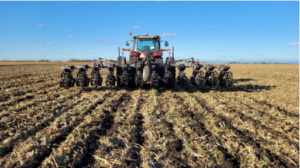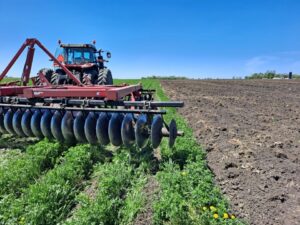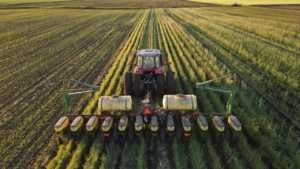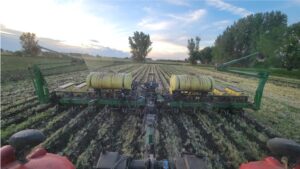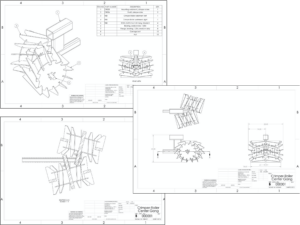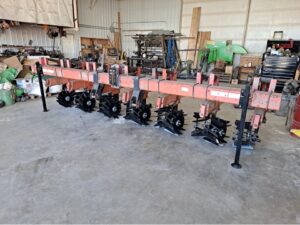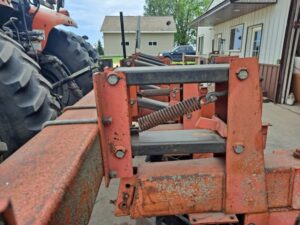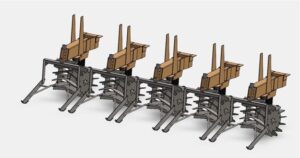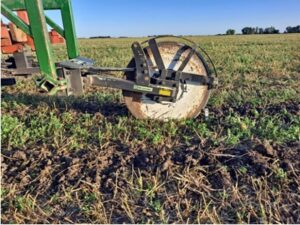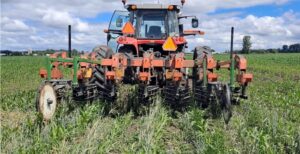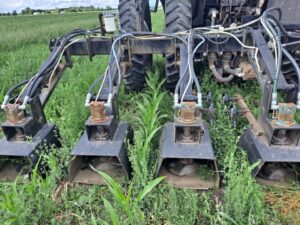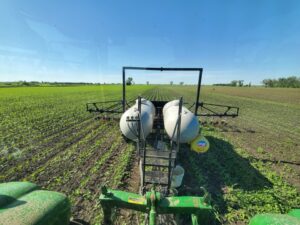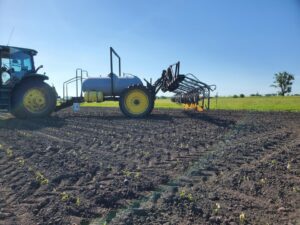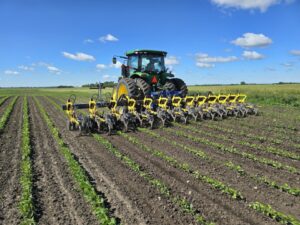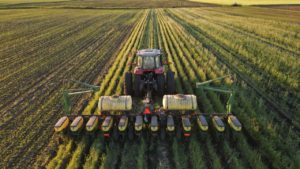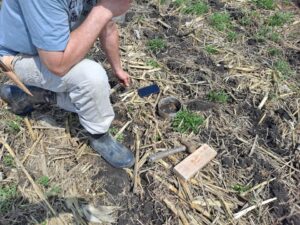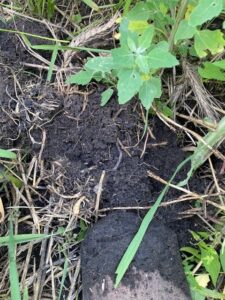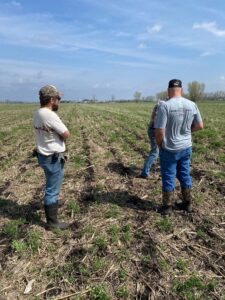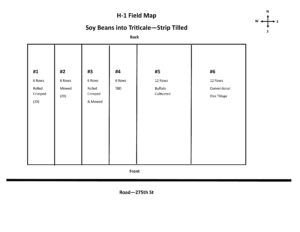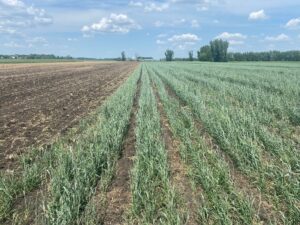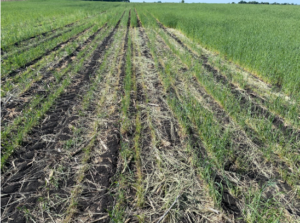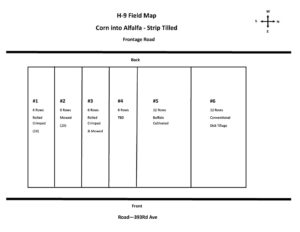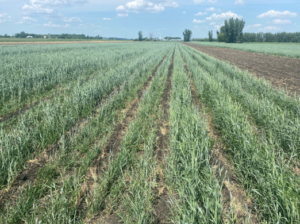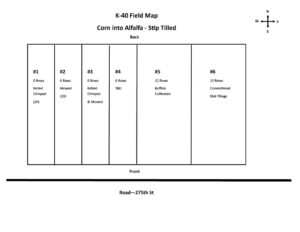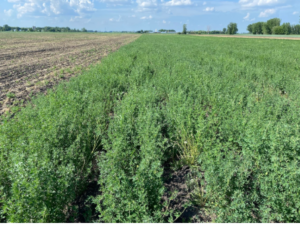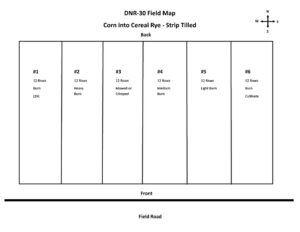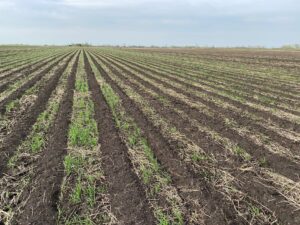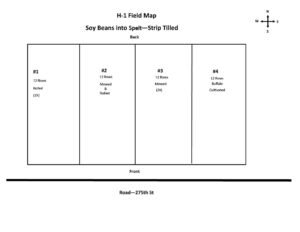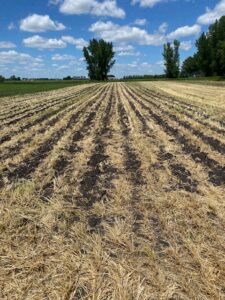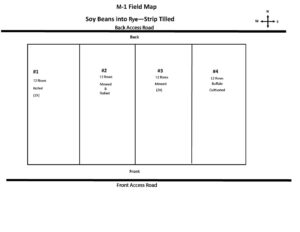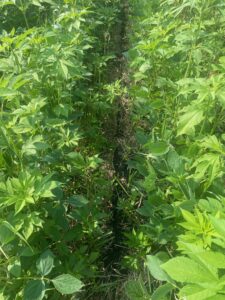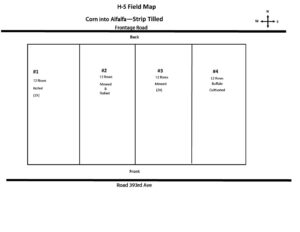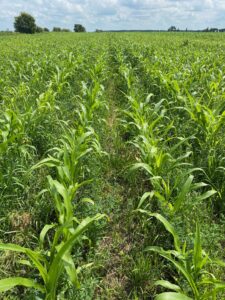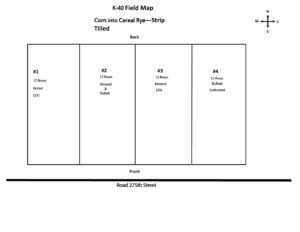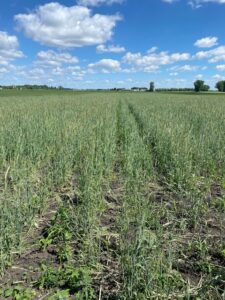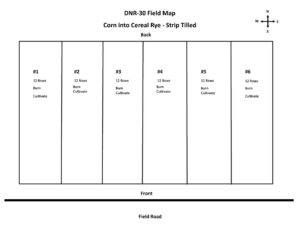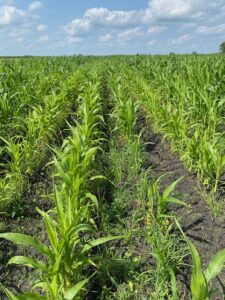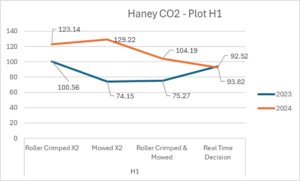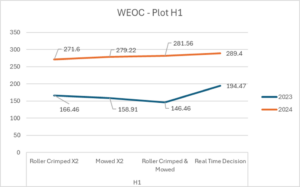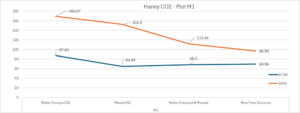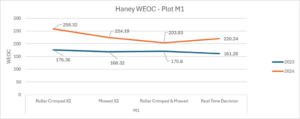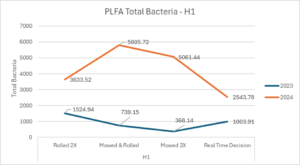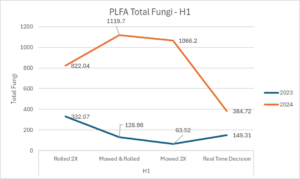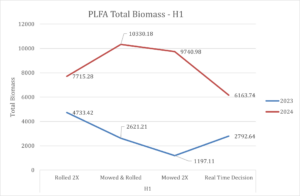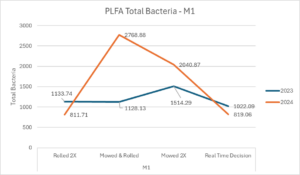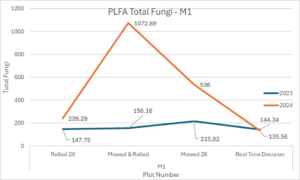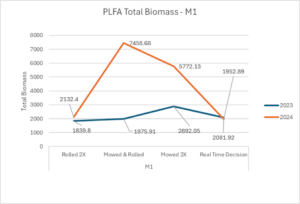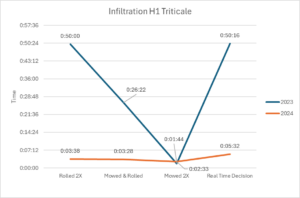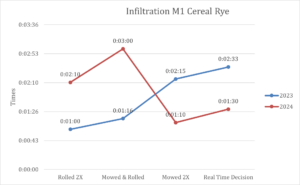Final report for ONC23-124
Project Information
The goal of this proposed project is to investigate if there is potential to improve soil health in a manageable and scalable way in organic farming. Specifically, to reduce the amount of tillage while increasing cover crop bio-mass and managing weeds in organic agriculture. Tillage is one of the major weed management tools in organic agriculture and is detrimental to soil health. This level of disturbance makes soil more susceptible to erosion by wind or runoff, damages soil structure and biology and requires large amounts of fuel and labor. This study brings together the benefits of strip tillage, living mulch, row mowing, RTK guidance, and cover crop diversity, on a scale adaptable to organic commercial crop farmers. Extending cover crop growth and controlled mulching can improve rainfall absorption and sequester more carbon while reducing labor and fuel requirements. The farms are located in Belgrade, MN and are representative of organic farms in the upper Midwest.
This innovative project will use strip till in combination with cover crops and compare mowing, rolling and cultivating between rows for cover crop management. The project will also determine best cover crop mixes and try new equipment modification ideas.
- Identify improvements to soil health from these practices
- Feasibility of mowing cover crops in between rows in a commercial organic system
- Feasibility of crimping cover crops in between rows in a commercial organic system
- Feasibility of cultivating cover crops in between rows in a commercial organic system
- Yield impacts
- Best practices for managing strip till and cover crops in an organic system
- Ideal cover crop mixes for strip till and cover crops in an organic farming system
- Equipment needs and modifications
- Monitor weed pressure/suppression
Cooperators
Research
MATERIALS
The materials used in this study are considerable in terms of items as well as diversity of applications–to increase the readability and navigation of present & used materials this section is broken down by the participants in the study: Joe Borgerding, Dan & Tom Borgerding, and Chris and James Schropfer. Under the participants, materials are further broken down by Parcels, Crops (Cover and Cash), and Equipment/Technology. Finally, Testing & Equipment that best relates to their use in the project is broken down in its own section at the end.
MATERIALS–JOE BORGERDING:
PARCELS:
This materials section breaks down fields and parcels and which participant provided the materials (parcel) used in the project. Each participant's parcel is given an identifying label as well as the amount of rows in each field:
TABLE: MATERIALS 1.1–J. BORGERDING–PARCELS 2023
|
J.BORGERDING 2023 |
||
|---|---|---|
|
M1 2023 |
H1 2023 |
H9 2023 |
|
FIELD I: 12 ROWS |
FIELD I: 6 ROWS |
FIELD I: 6 ROWS |
|
FIELD II: 12 ROWS |
FIELD II: 6 ROWS |
FIELD II: 6 ROWS |
|
FIELD III: 6 ROWS |
FIELD III: 6 ROWS |
FIELD III: 6 ROWS |
|
FIELD IV: 6 ROWS |
FIELD IV: 6 ROWS |
FIELD IV: 6 ROWS |
|
FIELD V: 6 ROWS |
FIELD V: 6 ROWS |
FIELD V: 12 ROWS |
|
FIELD VI: 6 ROWS |
FIELD VI: 6 ROWS |
FIELD VI: 12 ROWS |
MATERIALS–J. BORGERDING cont.
TABLE: MATERIALS 1.2
|
J.BORGERDING 2024 |
||
|---|---|---|
|
M1 2024 |
H1 2024 |
H5 2024 |
|
FIELD I: 12 ROWS |
FIELD I: 6 ROWS |
FIELD I: 12 ROWS |
|
FIELD II: 12 ROWS |
FIELD II: 6 ROWS |
FIELD II: 12 ROWS |
|
FIELD III: 6 ROWS |
FIELD III: 6 ROWS |
FIELD III: 12 ROWS |
|
FIELD IV: 6 ROWS |
FIELD IV: 6 ROWS |
FIELD IV: 12 ROWS |
CROPS:
Crops expressed by tables are broken down by parcel number, cover crop used, as well the cash crop that was planted–tables are differentiated by the year in which the crop combination was used.
TABLE: MATERIALS 1.3
|
J. BORGERDING CROPS BY PARCEL–2023 |
|||
|---|---|---|---|
|
PARCEL |
M1 |
H1 |
H9 |
|
COVER CROP: |
Cereal Rye |
Triticale |
Alfalfa |
|
CASH CROP: |
Soybeans |
Soybeans |
Corn |
TABLE: MATERIALS 1.4: JOE BORGERDING CROPS 2024
|
J. BORGERDING CROPS BY PARCEL–2024 |
|||
|---|---|---|---|
|
PARCEL |
M1 |
H1 |
H5 |
|
COVER CROP |
Volunteer Rye |
Spelt Stubble |
Alfalfa |
MATERIALS JOE BORGERDING cont.
TABLE: MATERIALS 1.4 cont.
J. BORGERDING CROPS BY PARCEL–2024 |
|||
|---|---|---|---|
|
PARCEL |
M1 |
H1 |
H5 |
|
CASH CROP: |
Soybeans |
Soybeans |
Corn |
MATERIALS–DAN & TOM BORGERDING
PARCELS
The participants had a total of 1 test plot–identified as K40–The amount of rows did not change between 2023 and 2024.
TABLE: MATERIALS: 2.1
|
K-40–2023 |
|||||
|---|---|---|---|---|---|
|
K40 |
|||||
|
FIELD I |
FIELD II |
FIELD III |
FIELD IV |
FIELD V |
FIELD VI |
|
6 ROWS |
6 ROWS |
6 ROWS |
6 ROWS |
12 ROWS |
12 ROWS |
TABLE: MATERIALS 2.2
|
K-40–2024 |
|||
|---|---|---|---|
|
K40 |
|||
|
FIELD I |
FIELD II |
FIELD III |
FIELD IV |
|
6 ROWS |
6 ROWS |
6 ROWS |
6 ROWS |
CROPS
Crops are expressed by tables which are broken down by parcel number, cover crop used, as well the cash crop that was planted–tables are differentiated by the year in which the crop combination was used.
MATERIALS: D. & T. BORGERDING cont.
TABLE: MATERIALS: 2.3
|
D. & T. BORGERDING–CROPS 2023 |
||||||
|---|---|---|---|---|---|---|
|
FIELD |
I |
II |
III |
IV |
V |
VI |
|
COVER CROP |
ALFALFA |
ALFALFA |
ALFALFA |
ALFALFA |
ALFALFA |
ALFALFA |
|
CASH CROP |
CORN |
CORN |
CORN |
CORN |
CORN |
CORN |
TABLE: MATERIALS: 2.4
|
D. & T. BORGERDING–CROPS 2024 |
||||
|---|---|---|---|---|
|
FIELD |
I |
II |
III |
IV |
|
COVER CROP |
CEREAL RYE |
CEREAL RYE |
CEREAL RYE |
CEREAL RYE |
|
CASH CROP |
CORN |
CORN |
CORN |
CORN |
MATERIALS–JAMES AND CHRIS SCHROPFER
PARCELS
TABLE: MATERIALS 3.1–PARCELS SCHROPFER 2023
|
DNR30–2023 |
|||||
|---|---|---|---|---|---|
|
FIELD I |
FIELD II |
FIELD III |
FIELD IV |
FIELD V |
FIELD VI |
|
12 ROWS |
12 ROWS |
12 ROWS |
12 ROWS |
12 ROWS |
12 ROWS |
TABLE: MATERIALS 3.2–PARCELS SCHROPFER 2024
|
DNR30–2023 |
|||||
|---|---|---|---|---|---|
|
FIELD I |
FIELD II |
FIELD III |
FIELD IV |
FIELD V |
FIELD VI |
|
12 ROWS |
12 ROWS |
12 ROWS |
12 ROWS |
12 ROWS |
12 ROWS |
MATERIALS: SCHROPFER cont
CROPS
TABLE MATERIALS: 3.1–CROPS 2023
Crops are expressed in the same manner as Joe, Dan, & Tom Borderding's crop material tables. Crop by tables are broken down by parcel number, cover crop used, as well the cash crop that was planted–tables are differentiated by the year in which the crop combination was used. There was o
TABLE: MATERIALS 3.2–SCHROPFER CROPS 2023
|
C. & J. SCHROPFER–CROPS 2023 |
||||||
|---|---|---|---|---|---|---|
|
PARCEL # |
I |
II |
III |
IV |
V |
VI |
|
COVER CROP: |
Cereal Rye & Barley |
Cereal Rye & Barley |
Cereal Rye & Barley |
Cereal Rye & Barley |
Cereal Rye & Barley |
Cereal Rye & Barley |
|
CASH CROP |
CORN |
CORN |
CORN |
CORN |
CORN |
CORN |
TABLE: MATERIALS 3.3
|
C. & J. SCHROPFER–CROPS 2024 |
||||||
|---|---|---|---|---|---|---|
|
PARCEL |
PARCEL I |
PARCEL II |
PARCEL III |
PARCEL IV |
PARCEL V |
PARCEL VI |
|
COVER CROP: |
Winter & Italian Rye |
Winter & Italian Rye |
Winter & Italian Rye |
Winter & Italian Rye |
Winter & Italian Rye |
Winter & Italian Rye |
|
CASH CROP: |
Corn |
Corn |
Corn |
Corn |
Corn |
Corn |
.
TESTING MATERIALS:
- Shovel (Visual Test to Observe root systems, insects and & present in soil)
- PLFA Test
- Penetrometer
- Thermometer Probe
- Haney Test
- Infiltration Testing Ring
- Chloroform-Fumigation Extraction/Reader (Biomass Testing)
EQUIPMENT:
Different equipment was utilized for each test plot. As well as the development of different equipment for management was developed as a result of this project. All plots were Strip-Tilled by a Hiniker Strip-Tiller to minimize tillage/soil disturbance and to inter-seed cover crops with the cash crops. A combine was used to harvest the crops.
Hiniker Strip Tiller:
The Hiniker Strip Tiller was used by all participants in Strip Till all parcels/plots in the experiment in order to be in congruence with our hypothesis. The Strip Tiller allowed participants to plant cover crops and prepared the parcels for interseeding cash crops. In Borgerding 10”
IMAGE: HINIKER STRIP TILLER
Standard Disk Cultivator
The Standard Disk Cultivator was used as the “control” in our experiment regarding Strip-Tilling. This is in order to compare the yields, soil-conditions, and biological markers to the strip-plots to test our hypothesis. The tiller was assisted by the RTK Guidance system to improve accuracy.
Image: Standard Disk Cultivator
RTK GUIDANCE SYSTEM/PLANTER:
For our study, we used a planter with an RTK guidance System in order to accurately interseeded between filled rows. Each participant used the RTK Guidance System on each Parcel/Plot–a consistently utilized tool in the study in order to effectively inter-seed cash crops in between rows of standing cover crops.
IMAGE: PLANTER
IMAGE: RTK GUIDANCE SYSTEM IN BETWEEN ROWS
Proprietary Roller/Crimper:
A large component of our study’s prescribed management method was the Roller Crimper. Dan & Tom Borgerding developed a proprietary roller-crimper using Solidworks® and used an old cultivator bar to mount the Rollers/Crimps. –However, issues primarily related to wrapping caused problems with implementing the Roller-Crimper in the study–thus Joe, Dan, & Tom worked to modify the Roller-Crimper to improve its efficacy. In this subsection, the modifications added to improve the roller crimper will be included along with the corresponding image and modification description. The crimper roller modified with more weight, stabilizers to achieve better stability when in use as well as a crop guide to better target weeds and other materials.
IMAGE: ROLLER CRIMPER CENTER-GONG SCHEMATICS
IMAGE ROLLER CRIMPER 1.1
IMAGE: ROLLER MODIFIED WITH MORE WEIGHT TO INCREASE DEPTH
ROLLER CRIMPER MODIFIED WITH CROP GUIDE SOLIDWORKS DESIGN:
STABILIZER AND ALIGNMENT COULTER
IMAGE: ROLLER CRIMPER STABILIZER
IMAGE: ROLLER-CRIMPER ALIGNMENT COULTERS
ROW MOWER
The row mower was used to effectively target weeds and cover crops when using Mowing as a management practice the Row Mower was in a “Turtle in A Box” Configuration. Furthermore, to increase the accuracy of the Row-Mower it was modified with Side Sweeps and Cut-Aways. Row Mower in a “Turtle in A Box Configuration” which helps cut at the base of the crop as it provides a mulching effect in the mowed areas providing soil coverage/nutrients to the mowed areas but also to the cover crops.
IMAGE: ROW MOWER
IMAGE: ROW-MOWER MODIFICATION: CUT-AWAYS AND SIDE SWEEPS:
BURNER
The burner was used extensively in 2023 and 2024 on James and Chris Schropfer’s DNR30 plot as burning was one of the allowed management practices for DNR land. The burner was used in-between rows and on various burn settings: light, medium, and heavy to observe in order to help identify what the most effective intensity was as a management practice being utilized in 2023 on all of parcel DNR30’s fields with the exception of Field III which was Crimped/Rolled. In 2024 only one management practice was used via burning–Burn/Cultivate across the test plot fields #1-6.
BURNER USAGE IMAGES:
IMAGE: BURNER FRONT VIEW
IMAGE: BURNER SIDE VIEW
BUFFALO CULTIVATOR:
The Buffalo Cultivator was an alternative mechanized management tool to the roller/crimper, mower, and burner. Specializing in High-Residue conditions like those in our test plot it facilitates crop/weed management in the rows. It helped minimize soil/crop disturbance keeping in line with the parameters of our hypothesis.
IMAGE BUFFALO CULTIVATOR:
METHODS
IMAGE: Planter Planting in Between Rows of Cover Crops
While the goal of this study was to measure the impact of strip-tilling with cover crops as a management practice for organic farms the three participants of the study John Borgerding, Dan and Tom Borgerding, and Joe Schropher used various/differing management practices. The goal of this study is not only to test the feasibility of our hypothesis but to learn and infer what management practices are most effective at increasing measured metrics: Biomass, PLFA, Haney Test, Soil Temperature/Infiltration, and Observed Insect and Worm density and variety as well as retaining/improving yields. This section of the report will be differentiated between the Borgerding(s) and Schropher Plots respectfully as well as between the 2023 and 2024 growing seasons. However, the measurement methods as well as the methods of management are broken down for the sake of clarity by farmer, parcel, and year. Methods are also further broken down by crop combination and management practice.
MEASUREMENT PRACTICES
To test the results of our management methods we utilized a wide array of testing parameters. The measurements were taken once every month* and were conducted on each of the testing plots used in the study and broken down further by testing identified rows within the parcels. Further measurement tools/practices utilized in this study were as follows:
- Date/Time of Observation
- Soil Temperature on the surface
- Soil Temperature according to probe
- Weather Conditions during testing (forecast, temperature)
- Pentromer Compaction Reading ( Sampled front and/or middle and/or back)
- Infiltration Readings (Sampled front and/or middle and/or back)
- Biomass Readings (front and/or middle/and or back)
- Observations of Shovel Testing: Insects, Soil Condition, Root Content, and Worm Content
- Observed Weed Pressure of Parcel
- Haney Test
- Phospholipid Fatty Acid (PLFA) Test
A wide array of tests was conducted to get a holistic evaluation of the condition of the soil and the crops with both visual observations ie; current weather conditions, shovel tests (for soil, root system/condition, the prevalence of organics–insects and worms, and soil conditions), weed pressures, crop condition, as well as observation of measurements. Tests monitoring various metrics such as soil temperatures via probe, penetrometer readings, biomass readings, Haney & PLFA Tests, and infiltration times to get real-time numerical results to see the impacts of the various participant's management practices in real-time. Each of these measurements with the exception of the Haney/PLFA tests (see below) was conducted on each parcel from May-August with an additional test in November of 2023.
PLFA & HANEY TESTS/TEST DATES
PLFA tests were conducted on each Parcel and Field to assess the microbial composition/biomass of the soil. Haney tests were also conducted to understand the more detailed composition of the nutrients and nutrient values in the soil specifically The test measures Carbon, Nitrogen, Phosphorous, Potassium, Aluminum, Iron, and Calcium along with soil respiration. Both PLFA and the Haney test were administered by RegenAg Lab.
FIELD TESTING
Field Testing played an important role in our observations and findings–for each participants' parcel–field tests were conducted by Mark Gutierrez, Tim Radebach and Richard Rohrer, and the participants of the study in conducting visual observations, taking notes, and using a variety of testing ie; shovel observation, penetrometer, moisture, and temperature readings to observe soil conditions over time. Primarily when conducting Field Experiments our goal through our testing/measurement practices was to develop a holistic approach in order to sequester a multi-faceted set of metrics that we could analyze in our results.
IMAGE: INFILTRATION TEST
IMAGE: SHOVEL OBSERVATION TEST
IMAGE PENETROMETER READING:
METHODS: JOE BORGERDING 2023
This section lists Joe Borgerdings 2023 management methods for each parcel and field: in 2023 Borgerding(s) used four fields with cash crops and cover crops. Six test plots were utilized with 4 prescribed management practices to test the impact in terms of yield, soil condition, and inputs. Each field had a control field managed with conventional disk tillage to test to compare between the strip-tilled plots.
H-1:
In 2023 Filed H-1 previously had been a Strip-Tilled for the last 3 years and was planted to alfalfa with Triticale being planted in the fall of 2021. In this plot Soybeans were planted into standing Triticale in the Fall 2022. The field was strip-tilled with the exception of Field VI–which was conventionally disc–tilled. Each plot had a different/respective management practice. Visual Observations/Measurements were conducted.
TABLE: H1 MANAGEMENT PRACTICES
|
CASH CROP: SOYBEANS |
COVER CROP: TRITICALE |
|
PLOT # |
MANAGEMENT PRACTICE |
|
I |
ROLLER CRIMPED x2 |
|
II |
MOWED x2 |
TABLE: H1 MANAGEMENT PRACTICES cont.
|
III |
ROLLER CRIMPED AND MOWED |
|
IV |
TBD* |
|
V |
BUFFALO CULTIVATED |
|
VI |
CONVENTIONAL DISC TILLAGE |
Note: Section marked TBD* indicates that the management practice used was discretionary and was any combination of the other listed management practices–was based on “eyeballed” observation of what the crops/field needed at the given time.
IMAGE: H1 06/01/2023
M-1:
In 2023 Parcel M-1 was managed by Joe Borgerding and was previously not Strip–Tilled and had previously been conventionally managed organic for the last 5+ years. Rye was planted in 2022 in each field and all fields with the exception of our control: Field I was Strip-Tilled with Soybeans being planted into Standing Rye. There were two access fields to the north and south of the parcel Each plot had a designated prescribed management practice illustrated by the figures below. Visual Observations/Measurements were conducted.
M-1 FIELD MAP:
TABLE: M-1 MANAGEMENT METHODS
|
CASH CROP: SOYBEANS |
COVER CROP: RYE |
|
PLOT # |
MANAGEMENT PRACTICE |
|
I |
ROLLER CRIMPED x2 |
|
II |
MOWED x2 |
|
III |
ROLLER CRIMPED AND MOWED |
|
IV |
TBD* |
|
V |
BUFFALO CULTIVATED |
|
VI |
CONVENTIONAL DISC TILLAGE |
Note: Section marked TBD* indicates that the management practice used was discretionary and was any combination of the other listed management practices–was based on “eyeballed” observation of what the crops/field needed at the given time.
IMAGE: FIELD M1–06/01/2023
H-9:
In 2023 H-9 was planted with Corn into Alfalfa. In the Fall of 2022, Alfalfa was planted in the parcel with each plot with the exception of our H-9 control: Field VI was Strip-Tilled. Each plot was given a designated management practice (see: H-9 Field Map/Management Practices). There were two public roads for access to the south and south of H-9. For further context regarding the designated management practices see the figures and illustrations on the next page. Visual Observations and Measurements were conducted.
H-9 FIELD MAP
TABLE: H-9 MANAGEMENT PRACTICES
|
CASH CROP: CORN |
COVER CROP: ALFALFA |
|
PLOT # |
MANAGEMENT PRACTICE |
|
I |
ROLLED CRIMPED x2 |
|
II |
MOWED CRIMPED x2 |
|
III |
ROLLER CRIMPED AND MOWED |
|
IV |
TBD* |
|
V |
BUFFALO CULTIVATED |
|
VI |
CONVENTIONAL DISC TILLAGE |
*Note: Section marked TBD* indicates that the management practice used was discretionary and was any combination of the other listed management practices–was based on “eyeballed” observation of what the crops/field needed at the given time.
IMAGE: PARCEL H-9
METHODS: DAN & TOM BORGERDING 2023
K-40:
Field K-40 was managed by Dan & Tom Borgerding and has a Strip-Tilled Corn into the Alfalfa plot since 2021. The plot was strip-tilled with corn inter-seeded into standing Alfalfa from the previous year. The parcel was stripped and tilled with the exception of the K-40 control–Field VI. Each of the test plots was managed by a designated practice (See K-40: Field Map/Management Practice) and divided into Six Test plots Field: I–IV. The figures below provide further context into management practice assignments. Visual Observations and Measurements were conducted.
K-40 FIELD MAP:
IMAGE: K-40 FIELD II PLANTED WITH ALFALFA
TABLE: MANAGEMENT METHODS K-40 2023
|
CASH CROP: CORN |
COVER CROP: ALFALFA |
|
PLOT # |
MANAGEMENT PRACTICE |
|
I |
ROLLER CRIMPED x2 |
|
II |
MOWED x2 |
|
III |
ROLLER CRIMPED AND MOWED |
|
IV |
TBD* |
|
V |
BUFFALO CULTIVATED |
|
VI |
CONVENTIONAL DISC TILLAGE |
*Note: Section marked TBD* indicates that the management practice used was discretionary and was any combination of the other listed management practices–was based on “eyeballed” observation of what the crops/field needed at the given time.
METHODS: JAMES AND CHRIS SCHROPFER 2023:
DNR30:
In 2023 James & Chris Schropfers DNR30 test plot was a Corn planted into Standing Cereal Rye. Due to the field being rented on DNR land, there were certain restrictions regarding the management practices. In 2022 the field was planted with Green Peas planted in late July. In the Fall of 2022, barley was conventionally tilled. Drilled in Cereal Rye in the Fall of 2022. The field was parceled out in six different test plots 1-6. The plots were Stripped-Tilled and burned with different intensities with the exception of Field #3 which was Mowed & Crimped and Field #6 which was 12 rows that was conventionally managed with a disc-cultivator with the addition of a burn pass. There was an access road in the front of the parcel to access the plots.
TABLE: DNR 30 MANAGEMENT PRACTICES 2023
|
CASH CROP: CORN |
COVER CROP: CEREAL RYE |
|
PLOT # |
MANAGEMENT PRACTICE |
|
I |
BURN 2x |
|
II |
HEAVY BURN |
|
III |
ROLLER CRIMPED AND MOWED |
|
IV |
MEDIUM BURN |
|
V |
LIGHT BURN |
|
VI |
BURN/DISK CULTIVATE |
IMAGE: DNR30 05/10/2023
METHODS 2024
In 2024 the Methods for the study were broadly consistent with the methods in 2023. Namely conducting measurements with Field Tests ie; shovel tests, infiltration tests, temperature readings, and biomass testing. Testing via PLFA/Haney tests was conducted on each of the Parcel Test Plots/Fields by AgRegen Labs to provide a detailed account of soil composition, biochemistry, nutrients, etc. The Management practices were changed among all participants, namely the reduction of Joe, Dan, and Tom Borgerdings test plots per parcel going from six to four as well as Chris and James Schropfer reducing the test plot per parcel from six to one. Furthermore, Joe Borgerding relocated parcel H-9 and reclassified it as plot H-5. In 2024 one thing that should be noted amongst all participants is that the traditionally or conventionally managed field via disc-till was eliminated and all fields were strip tilled prior to planting. The reasoning of this decision to remove the control was in order to better manage the strip-tilled parcel and develop a more in depth understanding of the efficacy of the prescribed management practices.
METHODS: JOE BORGERDING 2024
The methods used on Joe Borgerding's parcels were similar to 2023 with some key changes–namely field H9 was relocated and the new parcel was designated H5. Furthermore, the number of fields within each parcel was reduced from six to four. Additionally, the number of management practices was reduced in Joe Borgerding's practice to correspond with the fewer plots. The crop combinations also somewhat differ from 2023. Visual observations were conducted.
H-1 2024:
In 2024 Soybeans were planted into Spelt. In the Fall of 2023, Spelt was planted and in the spring of 2024, the spelt was mowed and bailed in the spring. Later in the spring soybeans were interseeded/planted into the spelt. Another notable change was the reduction of management practices from six to four. One thing that should be noted in 2024 is that there was no control field–all fields were Strip-Tilled and there were no “conventionally managed” fields because Strip-till proved to be more successful for soil health.
H-1 FIELD MAP–2024:
TABLE: H-1 MANAGEMENT PRACTICES 2024:
|
CASH CROP: SOYBEANS |
COVER CROP: SPELT |
|
PLOT # |
MANAGEMENT PRACTICE |
|
I |
ROLLED 2X |
|
II |
MOWED & ROLLED |
|
III |
MOWED 2X |
|
IV |
CULTIVATED |
IMAGE: PARCEL H9 2024
M-1–2024:
In 2024 Joe Borgerding used the same crop combination as 2023–Soybeans into Rye. The beans were planted into standing rye in June of 2023 Like other other parcels managed by Borgerding in 2024 the number of management practice & test plots was reduced. no control plot–all plots are strip-tilled in 2024.
M-1 FIELD MAP–2024:
M-1 MANAGEMENT PRACTICES 2024:
|
CASH CROP: SOYBEANS |
COVER CROP: CEREAL RYE |
|
PLOT # |
MANAGEMENT PRACTICE |
|
I |
ROLLED 2X |
|
II |
MOWED & ROLLED |
|
III |
MOWED 2X |
|
IV |
CULTIVATED |
IMAGE: M1 FIELD I CLOSE UP
H-5 2024:
In 2024 field H-5 was a newly designated field taking the place of H-9. The field was relocated due to flooding/rainfall in the spring making H-9 unsuitable during the planting window. The field had been stripped-tilled Corn into Alfalfa the previous 3 years. Corn was planted into standing Alfalfa in June of 2024. Like other parcels in 2024, the number of management practices was four as compared to six in the previous year. Like with another parcel in 2024 there was no conventionally managed control field via Disc-Tillage. All fields/plots were strip-tilled in previous years. H-5 had public road access to the north and south.
H-5 FIELD MAP–2024:
H-5 MANAGEMENT PRACTICES 2024:
|
CASH CROP: CORN |
COVER CROP: ALFALFA |
|
PLOT # |
MANAGEMENT PRACTICE |
|
I |
ROLLED 2X |
|
II |
MOWED & ROLLED |
|
III |
MOWED 2X |
|
IV |
CULTIVATED |
IMAGE: H-5 FIELD III
METHODS: DAN & TOM BORGERDING 2024
K-40-2024:
In 2024–field K-40 was managed by Dan & Tom Borgerding in 2023. Furthermore, the crop combination in 2024 changed from Corn into Alfalfa to Corn into Volunteer/Cereal Rye. The parcel the year previous was Corn into Alfalfa and it is the 2nd year the field had been Strip-Tilled The Corn was planted into standing Rye approximately 3ft tall in the Spring of 2024. However, some of the Alfalfa from previous years came back into the field in patches so along with the planted rye, and had to be managed along with other weed pressures. The field had one access road to the south.
K-40 FIELD MAP:
TABLE: K-40 MANAGEMENT PRACTICES:
|
CASH CROP: CORN |
COVER CROP: CEREAL RYE |
|
PLOT # |
MANAGEMENT PRACTICE |
|
I |
ROLLED 2X |
|
II |
MOWED & ROLLED |
|
III |
MOWED 2X |
|
IV |
CULTIVATED |
Image: K-40 FIELD II STRIP-TILLED WITH GROWN ALFALFA
METHODS: CHRIS AND JAMES SCHROPFER 2024
DNR 30–2024:
One thing that should be noted when discussing the methods of the DNR30 testing parcel is that the DNR limited the practices that could be used–including limitations on weed control and crop combination. Due to heavy/rainfall in the spring of 2024 and the timing issues caused therein, the management practice was limited to one practice across the field as the acreage available was limited.
DNR 30 2024 FIELD MAP:
TABLE: DNR 30 MANAGEMENT PRACTICES 2024
|
CASH CROP: CORN |
COVER CROP: ALFALFA |
|
PLOT # |
MANAGEMENT PRACTICE |
|
I |
BURN & CULTIVATE |
|
II |
BURN & CULTIVATE |
|
III |
BURN & CULTIVATE |
|
IV |
BURN & CULTIVATE |
|
V |
BURN & CULTIVATE |
|
VI |
BURN & CULTIVATE |
IMAGE: DNR 30 STANDING CORN INTO ALFALFA
PUBLICATIONS AND OUTREACH
During the duration of our study, several outreach events and newsletters were distributed to the Minnesota Soil Health Coalition Community and abroad. SARE updates and awareness were included in our monthly newsletter distributed to 1,700+ individuals within the Minnesota Soil Health Coalitions community to raise awareness about our efforts and our study. We also plan to share this report with coalition members via our website to raise awareness about the SARE grant and the feasibility of Organic Strip Till best practices.
Additionally, we held a SARE research event findings presentation in Greenwald, MN on Dec 19th, 2024 where we had the SARE participants present their findings via PowerPoint and take questions regarding their experience and recommendations based on the challenges and successes of their SARE experience. We provided lunch to the participants and after lunch had a Q&A panel with farmers including Joe Borgerding, Tom Cotter, and Luke Peterson to answer questions about the research, soil health, regenerative farming, marketing, nutrients and grazing.
RESULTS/PROJECT OUTCOMES
FORWARD
Mentioned in this report previously was the weather conditions for 2023 and 2024 growing seasons being an intensely prohibitive factor in our ability to test under “normal conditions” The extent in which these conditions impacted the process and results our study is unknown but due to the impact it caused other producers is a factor meriting mention and consideration in any conclusion positive or negative we can ascertain from the study. While climate change and random weather patterns are at the forefront of the minds and methods of producers in the State, Nationally, and Globally, and unusual and inconsistent weather patterns are thought to become more regular it cannot be understated that the severity of the challenges the particular weather conditions with drought and excessive rainfall imparted on our study. Nevertheless, The tertiary objective of our study was to test the Feasibility of Organic Strip-Till and cover crops–meaning its ability to produce yields, reduce input costs and improve soil health. In that regard, certain management practices were shown to be more effective than others. However, a primary objective of these studies was to develop an enhanced understanding of which management practices were most effective/successful in achieving soil health, lower inputs while providing sustainable yields. In that regard the study provides meaningful results in regard to which management practices achieve those goals. Success was found in our secondary objectives of testing and understanding the impact the differing management practices had on soil composition and “health” in terms of nutrient/bio-marker density and abundance as well as the positive and negative impacts it had on biomass and the presence of organics and bio-markers.
JOE B, DAN, & TOM BORGERDING
In this section, Joe, Dan, & Tom Borgerding results are grouped as the management practices were the same among the participants. As stated in the foreword the 2023 & 2024 growing seasons posed unique challenges due to the historic drought. While results initially looked positive, the dryness quickly started to have negative impacts on the crop combination. The results of the 2023 study seemed to shift priorities from finding the best crop/management practice to increasing yields and reducing management costs. to what the crop/management practice was the most resilient to the drought conditions. In 2024 it seemed to be an exercise in which practice was more effective at managing excessive rainfall. That being said, the results of the 2023 & 2024 studies on fields H-1, M-1, K-40, H-9 (2023), & H-5 (2024) have given us an indication as to what management practice could be the most effective. Since the objective of this study was to ascertain the feasibility of strip-till organic farming the results section will discuss exclusively which management practice was the most conducive to the primary objective.
2023
In 2023 there were three test plots: M-1(Soybeans into Rye), H-1 (Soybeans into Triticale), K-40 (Corn into Alfalfa), and H-9 (Corn into Alfalfa). Each field had 6 test plots each with a different management practice: Rolling Crimping 2x, Mowing 2x, Rolling/Crimping/Mowing, Buffalo Cultivation, TBD (managed as needed), & Disc-Tillage. In fields H-9 and K40 there was a crop failure due to lack of moisture with the corn being outcompeted by the standing alfalfa and weed pressure with the rye being especially difficult to manage. In fields H-1 & M-1 drought and weed pressure caused very low yields. Overall the Roller-Crimper was unsuccessful in managing the weed pressure on the crops due to wrapping of the roller making it inoperable. Additionally, the mower was having issues with clogging. Thus, the crops were outcompeted and overtaken in various areas. Throughout the growing season, there was very little rain causing the heartier crops like Canadian Thistle to take hold and were very difficult to manage. Based on the results it's difficult to ascertain which management practice and crop combination was the most effective despite the conditions but our findings suggest that H-9 & H-1 Soybeans into Rye/Triticale seemed to indicate that cereal rye and triticale managed weeds better. In regards to soil condition–the best management for biomass was the Roller Crimper 2x & and Mower with the highest biomass readings. However, this may be due to the fact that these management methods were ineffective at managing the weed pressure within the till strip. Furthermore, the Roller/Crimper 2x was the best in terms of soil infiltration time, indicating that biomass, i.e. carbon added to the soil increases infiltration. Subsurface soil readings were fairly consistent in the fields and management practices. However, field M–1( Soybeans into Rye) performed the best at insulating the soil from the cold and the heat. Overall the results of weed pressure management were best with rye and triticale.
2024:
In 2024 there were three test plots H-1 (Soybeans into Spelt Stubble), M-1 (Soybeans into Volunteer Rye), K-40, and H-5 (Corn into Alfalfa). H9 was flooded and the timing was off in regards to the schedule of the experiment and thus was moved and redesigned to H-5. The number for test plots and management practices was reduced to four.
RESULTS-BORGERDING 2024
Rolled/Crimped/Mowed, Mowed 2x, and Mowed/Crimped/Mowed . In 2024 there were very heavy rains and flooding during the spring lasting through July. With very little rainfall July–September. In 2024 the roller crimper was reworked and modified with more weight, a stabilizer, alignment couplers, and a crop guide to address the wrapping and other major issues present in 2023. However still had issues with wrapping and depth of roller/crimper at managing weed pressure but was more effective overall. Furthermore, the mower was still having issues despite being modified with cutaways and side sweeps but still clogged and a brush mower was employed in conjunction to improve the efficiency. Overall the modified Roller/Crimper & Mower was more effective at managing weed pressure/Cover crops between rows but still struggled in efficacy and needed to be further reworked to address shortcomings. In terms of yields–while still impacted by weed pressures and the excessive rainfall and then drought field K-40 had the most abundant yields overall with Corn into Alfalfa/Clover. The management practice that seemed to be most effective based on our findings is Mowed/Crimped/Mowed. However, yields were still under expectations. Field testing was conducted once in 2024 on 06/14/2024 for fields K-40 & H1 and 07/24/2024 for fields M1 & H5. Based on field testing, Field H5 with the Rolling/Crimping management had the best infiltration times in the front and back as well as the best biomass readings. Furthermore, this field had the best compaction readings. However, in terms of yields, field H5 was low. We can conclude that based on the management practices in 2024 the Mowed/Crimping/Mowing with a crop combination of Corn into Alfalfa was the most successful in terms of yields.
Results - CHRIS AND JAMES SCHROPFER
In 2023 the Schropfers utilized a combination of differing burning intensity/cultivation as well as rolling and crimping. They had one Parcel of Land: DNR 30 with 6 different test-plots (#1-6). Each was planted with Corn into Cereal Rye. In 2024 the location of DNR30 was changed due to flooding and planting timing being inconsistent with the schedule of the study and thus was moved to a different 30 acres. Because the land was rented from the DNR the practices that could be utilized were limited. Like the Borgerdings–issues with the drought conditions in 2023 caused issues with yields and crop viability however due to its location being 10 miles south of the Borgerding farm they received slightly more rain and thus the throughout conditions were slightly alleviated. In 2024 excessive rainfall was a negative factor in terms of managing the crops and yields. Furthermore, the Schropfers used the same management practices throughout their new plot: Burning 2x and Cultivating. But struggled with weed management, specifically Canadian thistle.
2023
In 2023–The Schrofer had a single parcel: DNR30 with six different management practices for Corn into Cereal Rye and Barley. Burn 2x, Heavy Burn, Mowed & Crimped, Medium Burn, Light-Burn, & Burn & Cultivate. In the spring they Burned off the cover crop and while they experienced severe drought conditions they had more rain on their land than the Borgerdings and because of the early burning the Corn had more moisture that would otherwise have been absorbed by the Rye and Barley. Furthermore, the Burning was effective at managing the weed pressure on the plots where it was utilized. However, Field/Plot #3 that Mowed/Crimped experienced the same issues regarding weed pressure and moisture starvation due to the Rye and Barley outcompeting the Corn. The plots that utilized burning had good weed control–However, Canadian Thistle was prevalent and had tough weed pressure to manage. Furthermore, the plots that utilized burning had fairly decent yields for organic farming considering the drought conditions. One issue with ascertaining the efficacy of burning compared to the other management practices was the fact that Schropfers had more rain compared to the Borgerdings that did not utilize burning–it should be noted though that weed management appeared to be more effective as a management practice for weed pressure although it was not effective at reducing input costs while it had positive results in terms of yields. Biomass readings were low with the highest being in the field that mowed and crimped 5.2g and the lowest being in the field that was lightly burned (2.4g). But was low across all the fields as well compared to the Borgerdings fields. However, soil compaction was good and fairly consistent throughout the field. Infiltration times were the lowest in the field which was Heavy Burned but fairly consistent throughout the field.
2024
In 2024–due to timing and flooding the Schropfers moved their field to a DNR field that was 5 acres and limited the practices that could be utilized. They used the same management practice across the field Burn and Cultivate. They planted Corn into Alfalfa along with other standing foliage. While flooding and rainfall were an issue the Burning/Cultivation was fairly effective at managing weed pressure and providing the Corn space and nutrients to grow. However, as with 2023, the Canadian thistle was a challenge to manage and while yields were pretty good overall there were some isolated thick patches of thistle in the middle of the fields. One Field test was conducted and infiltration times were universally high indicating soil was highly saturated. The soil was moist with signs of worms and root systems. As with 2023–while burning was an effective tool for managing weeds and providing solid yields, the input costs in terms of fuel for the burning practice limit its feasibility.
Haney Results
Because of flooding, or drought that resulted in full tillage to manage weeds we were only able to compare plots H1 and M1 soil sample data and only plot #1-4 as a result of changes the farmers made to the number of plots because of workload and weather. The Haney Test was used to analyze the soil health status. We took a spring and a fall sample in 2023 and 2024.
Plot H1 – Triticale Cover Crop
This chart shows the increase of soil respiration across all of the management practices in Plot H1 – Triticale cover crop, except the real time decision plot, where in-season cultivation was the main difference. The increased respiration shows a growth in microbiology activity. This is an indication of increased soil health.
This chart shows the increase of Water Extractable Soluble Carbon across all of the management practices in Plot H1 – Triticale cover crop. The increased WEOC shows a growth in the amount of food available for biology. This is an indication of increased soil health and when coupled with the increase in soil respiration activity this shows that increased cover crops and reduced disturbance increases biology in the soil, even in extreme drought and extreme wet years.
Plot M1 – Cereal Rye Cover Crop
This chart shows the increase of soil respiration across all of the management practices in Plot M1 – Cereal Rye cover crop. The increased respiration shows a growth in microbial activity. This is an indication of increased soil health.
This chart shows the increase of Water Extractable Soluble Carbon across all of the management practices in Plot M1 – Cereal Rye cover crop. The increased WEOC shows a growth in the amount of food available for biology. This is an indication of increased soil health and when coupled with the increase in microbial activity this shows that increased cover crops and reduced disturbance increases biology in the soil, even in extreme drought and extreme wet years.
PLFA Results
Because of flooding, or drought that resulted in full tillage to manage weeds we were only able to compare plots H1 and M1 soil sample data and only plot #1-4 as a result of changes the farmers made to the number of plots because of workload and weather. The PLFA Test was used to analyze the soil health status. We took a spring and a fall sample in 2023 and 2024. We looked at 3 indications from the PLFA to demonstrate the increase in soil health, Total Bacteria, Total Fungi, Total Biomass.
Plot H1 – Triticale Cover Crop
We looked at total increase of bacteria in this chart to assess the soil health from 2023-2024. There was an increase in all plots which fits the Haney test indications of increased food and increased soil respiration.
We looked at total increase of fungi in this chart to assess the soil health from 2023-2024. There was an increase in all plots which fits with the increase in total biology and the Haney test indications of increased food and increased soil respiration. There was a significant increase in all practices with the smallest increase in the Real Time Decision plot where more cultivation took place. We know that increased disturbance has a negative impact on fungal biology.
We looked at total increase of biological biomass in this chart to assess the soil health from 2023-2024. There was an increase in all plots which fits with the increase in total biology, total fungi and the Haney test indications of increased food and increased soil respiration. There was a significant increase in all practices. These indications point to an overall increase in soil health with the increase of cover crops.
Plot M1 – Cereal Rye Cover Crop
We looked at total increase of bacteria in this chart to assess the soil health from 2023-2024. There was an increase in all plots which fits the Haney test indications of increased food and increased soil respiration.
We looked at total increase of fungi in this chart to assess the soil health from 2023-2024. There was an increase in all plots except the Real Time Decision plot where in-season cultivation was a major tool. We know that increased disturbance has a negative impact on fungal biology. The increases fit with the increase in total biology and the Haney test indications of increased food and increased soil respiration.
We looked at total increase of biological biomass in this chart to assess the soil health from 2023-2024. There was an increase in all plots except the Real Time Decision plot. The increases fit with the increase in total biology, total fungi and the Haney test indications of increased food and increased soil respiration. There was a significant increase in all practices. These indications point to an overall increase in soil health with the increase of cover crops.
Infiltration Summary
The methodology was to run an infiltration in test using an infiltration ring in multiple locations throughout the field and take an average. We avoided tracks and heavy traffic areas.
There were large reductions in infiltration rates in all plots except Mowed 2X from the addition of cover crops and residue.
2024 was an extreme wet year and we faced challenges conducting the infiltration. Plot M1 infiltration performed well in 2023 and 2024.
CONCLUSION
In conclusion, based on the findings among participants the management practice that was the most effective in terms of yields compared to input costs was the light-burning management practices which provided good weed control along with producing solid yields despite the severe drought conditions in 2023 and excessive rainfall in 2024. Furthermore, as stated in the foreword of the conclusion of this report it can not be overstated that the negative impact the drought conditions had in the 2023 portion of this study causing crop failures that could otherwise have been successful in fields Dan & Tom Borgerding’s K-40 & Joe Borgerdings H-9 which both used Corn as a cash crop and Alfalfa as cover which outcompeted the Corn for moisture especially in drought conditions. Furthermore, unstainable yields in Joe Borgerding M-1’s & H-1’s which used soybeans as the cash crops were unstainable regardless of management practices. Rolling-Crimping as well as mowing struggled to manage the weeds in both 2023 and 2024 so issues regarding wrapping with the Roller/Crimper and clogging with the Mowing need to be resolved before it can be implemented most effectively but showed improvement between 2023–2024. In 2024 the excessive rainfall and then the subsequent drought from July to September posed challenges as well with the Roller/Crimper & Mower struggling despite improvements. Schropfer’s Burning/Cultivation was effective overall at managing weeds however struggled with managing Canadian thistle. Regarding our research question of the feasibility of Strip-Till based on the prescribed management practices of our study and the sequestered conclusions, organic strip-till is feasible with the utilization of burn/cultivations with Corn & Soybeans with Alfalfa and Rye as a cover crop but faces issues with managing particularly resilient weeds like Canadian thistle as well as during times of extreme weather conditions experienced during the length of our study. Further testing after improvements to the Crimper/Roller & Mower during more typical weather conditions are recommended in order to better understand its efficacy during more ideal conditions.
Our recommendations for future research on this topic are to have a longer-range study. We saw immediate response from the soil and biology from soil health practices, but it would be great to have some data from a year without extreme weather events. In addition, the longer the practices are conducted the more soil health indicators are expected to show up and it would be good to document these changes. Any farmers interested in adopting soil health practices should work with a mentor, other farmers and get involved with a network.
Educational & Outreach Activities
Participation Summary:
We hosted a winter workshop in Greenwald, MN. Mark Gutierrez discussed the principles of soil health and the importance of working together to increase learning in a shorter timeframe. Joe, Chris and Dan all presented on different aspects of the project including successes, challenges and key takeaways. We also had a farmer panel of 3 organic farmers with different systems, Tom Cotter, Luke Peterson and Joe Borgerding discussed their systems and answered questions on implementing cover crops and reduced tillage in organic systems.
Learning Outcomes
Project Outcomes
This project helped 3 farmers to conduct on-farm research with a lower risk and helped them transition into soil health practices. These farmers saw the benefits of reduced tillage and cover crops and were able to learn best management practices in a lower risk and organized system. They also became more familiar with the MN Soil Health Coalition and attended field days, conferences and the Soil Health School. They found mentors and connected with other farmers though that network and have a strong group to share ideas and solutions to challenges that will arise on their soil health journey.
These farmers will continue to implement soil health practices going forward.
